Feral Horses of the Barrier Islands - Eastern United States
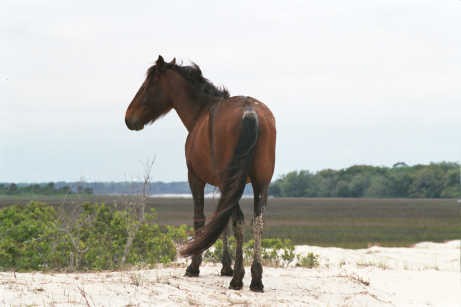 |
Cumberland Island, Georgia
| Cumberland
Island
is 17.5 miles long and totals 36,415 acres of which
16,850 are marsh, mud flats, and tidal creeks. It is
well known for its sea turtles, wild turkeys, wild
horses, armadillos, abundant shore birds, dune fields,
maritime forests, salt marshes, and historic structures.
For information on Cumberland Island's wild horses
visit: Cumberland
Horses |
| In April 2005, my two friends and
colleagues (Derry McCormick and Steve Dick) and I took off
for a week and went to Cumberland Island - a protected
National Seashore - off the coast of Georgia. Our purpose
was to take a look at the wild horses living
there. We had always had our doubts about the claims
of some that wild horse feet all look the same, no matter
where they are. That just did not seem to be reasonable,
especially since both Steve and I have our hoof care
businesses in the Southeastern USA where it is wetter and
softer than the high desert biomes that produced the feral
hoof specimens most commonly viewed. So we decided to trek
on out and see for ourselves. As you view these images, you will notice some of the same horses in each of the different regions of the island. We noticed that each family group migrated throughout the day to different areas where different types of forage could be found. They are just as territorial as horses in other biomes, but we believe that because the island is a relatively small land mass, these horses must shift their "turf" so that everyone has access to sufficient nutritional variety. A family group might start out on the dunes, then move to the forest, later on to the marshes, and so on. They seemed to be intent on defending whatever area they were in at the time, then move on out and let another group come in. I would compare it to a gypsy lifestyle...constantly on the move and their territory is where ever they happen to be at the time. We explored only about 1/3 of the island - the southern 1/3, and saw only 50 of the estimated 250 horses reported to be living there. We plan to extend our exploration to other areas of the island on our next trip. Copyrite Notice: All images on this page are the property of of Cindy Sullivan, Derry McCormick and Steve Dick. They may be reproduced for educational purposes only with appropriate credits given. They may not be reproduced for commercial purposes. |
Cumberland Island Wild Horses
The Ruins of Dungeness We observed a number of horses around the Dungeness ruins, a popular stop for human visitors to the island. The horses were unconcerned about our presence and went about their business as if we were not there. |
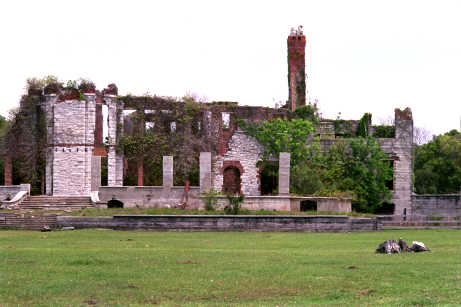 |
| This bachelor band was the largest grouping we saw during our trip. These boys gave us a lively display of stallion sparring and chases. | 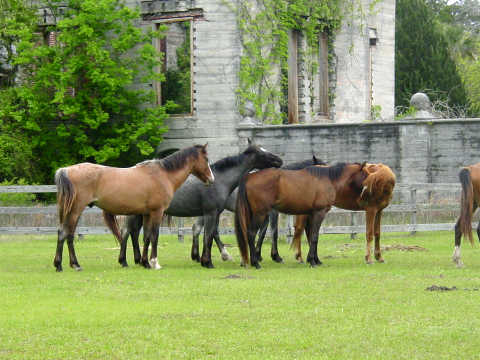 |
| Park personnel warn visitors before arrival to the island, that according to the horses, the island belongs to them. They do not care about humans and if they are coming down a trail, you should yield the right of way because they won't. We found that to be true early in our trip as these bachelors raced about the ruins nearly running over us as if were were part of the landscape. |  |
| Bachelor feet on one of the
internal access roads used by park personnel. Vehicles are
not permitted on the island other than those used by the
staff. These roads are primarily composed of hard packed,
crushed shell. We even found an occasional shark tooth
while walking along these roads. With such an abrasive surface, we would have expected well worn feet much like the western wild horses, however we soon realized that the daily migration of all the horses seemed to require some hoof length for traction in areas like the dunes. If these horses spent all their time on this surface, I imagine their feet would be short and sporting the mustang roll we are all used to seeing. |
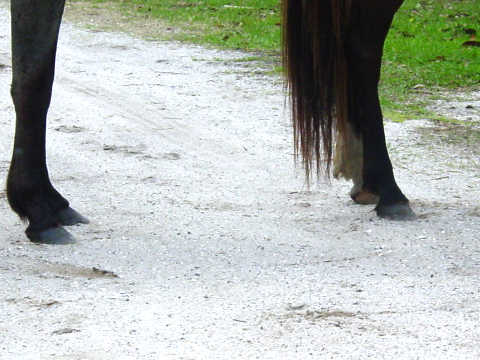 |
| We saw some astonishingly
long toes on some amazingly sound horses. |
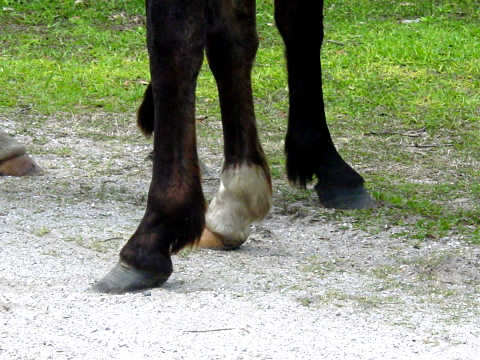 |
| These feet appear to be in
the process of a self trim. |
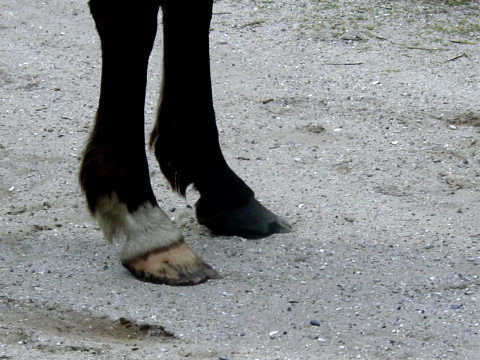 |
| This boy has already
trimmed of a good bit of his long toes. |
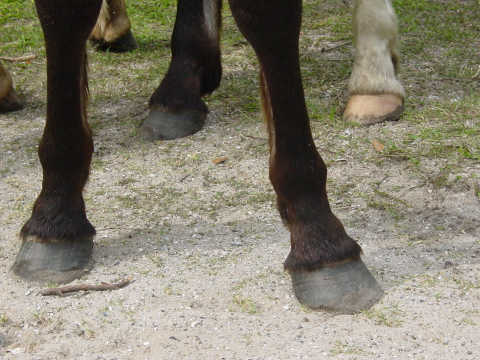 |
| This nice print was left on
the hard packed crushed shell road and was left by a foot
with a long, shovel toe. |
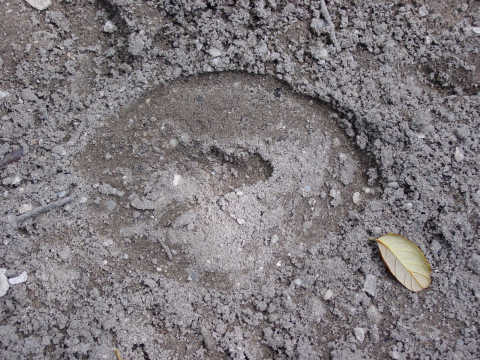 |
| Same print. Its easier to
see in this view how long the hoof wall is, especially at
the toe and how far the surface pressed up into the volar
concavity. |
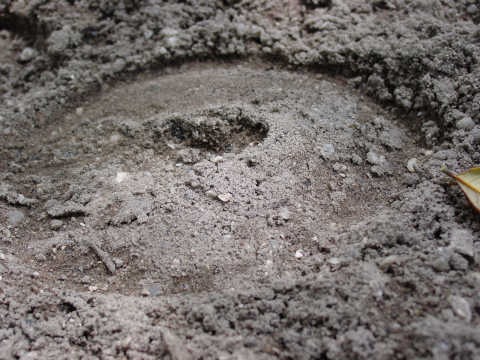 |
| The aged mare to the left was taking a rest in the grassy areas around Dungeness | 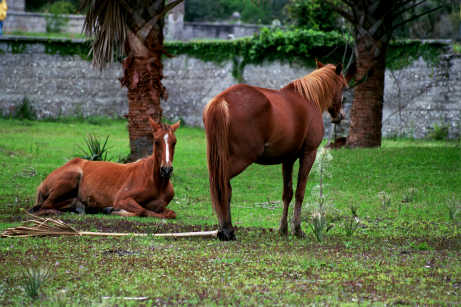 |
| This is the mare's front
foot. Her lack of concern over our proximity plus a zoom
lens made this close up shot possible. The heel, toes, and walls are quite long all the way around the foot. The frog is pressed up into the volar dome and the sole is deeply concave. The edges of the walls were fairly thin. We assume that is for traction on soft spongy terrain as well as what I personally discovered was a vital need for traction on sand dunes. |
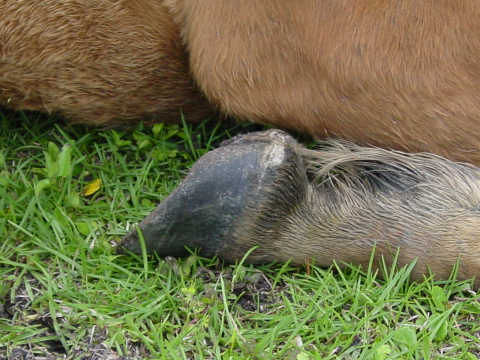  |
| Same mare, hind foot | 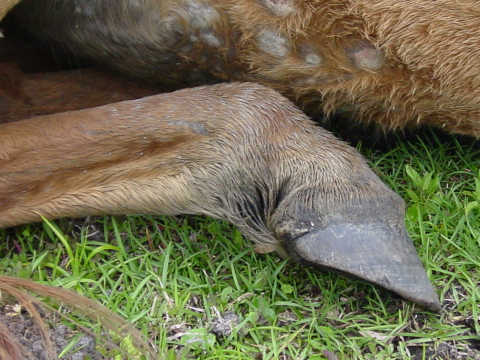 |
| This pregnant mare ( to the right of the resting aged mare in the image above) is drinking from what appeared to be an old artesian well near the Dungeness ruins. It was clear by the foot print around it that horses frequented this water source. It was also interesting to note the the abundance of algae growing in the otherwise crystal clear water. |
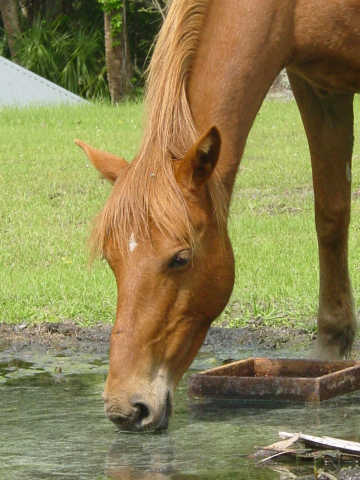 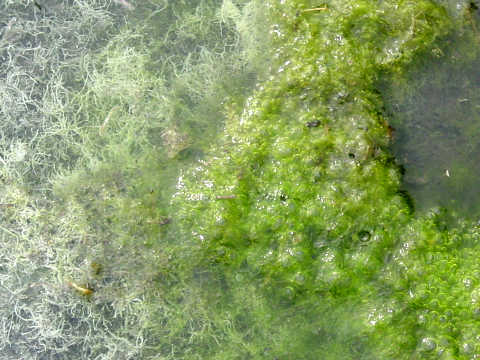 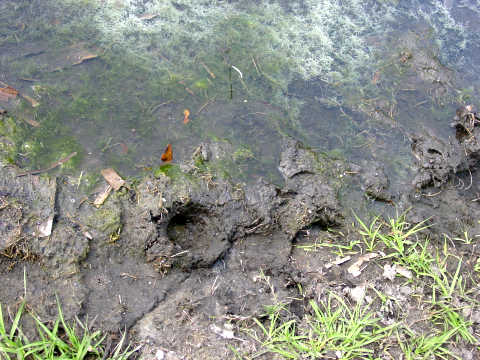 |
| Here she was so kind as to
show us her foot while she chased an itch! It was virtually the same as those on the aged mare. |
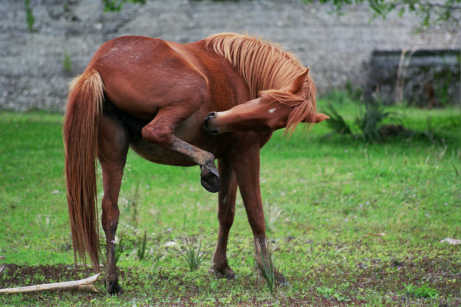 |
| Later a yearling, or
possibly a two year old and a young stallion arrived at
the artesian well for a drink. |
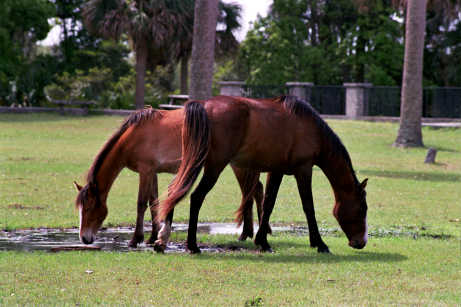 |
| It was early into foaling
time and many of the mares were heavy with their
pregnancies, or had newborns at their side. Nearly every
mare of breeding age had scarring on her withers as well
as what looked like scarring from relentless fly bites. We
guessed that the stallions were biting during breeding and
the flies were probably drawn in what must be unbearable
numbers to the bleeding wounds. We noticed that most of the horses were in small groups which tended to consist of one stallion, one adult mare, the foal from the previous year and either this years new foal was already on the ground or was very near to being born. In this picture is a mare, a stallion and this year's foal we guess to be only a week, or two old. |
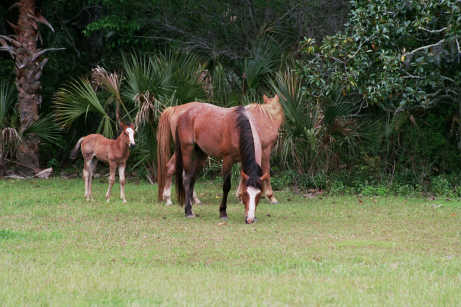 |
| This little girl, like her
parents, was unconcerned about us as she lay down for a
nap. Every new foal we saw was a filly. We found that interesting in light of the much higher numbers of stallions versus mares in the fifty, or so horses we observed. Nature seemed to be adjusting the gender balance this year! |
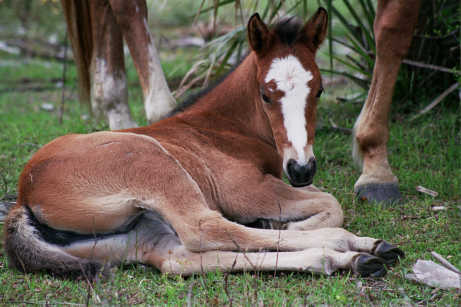 |
| We were able to get a great view of her beautiful little feet. | 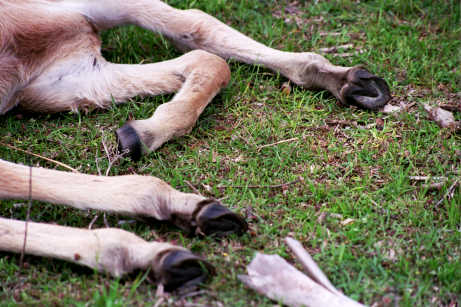 |
| In addition to sparse grass
around Dungeness, there were patches of clover and
areas of various broad leaf plants. The clover seemed to
be confined to this area around the ruins. |
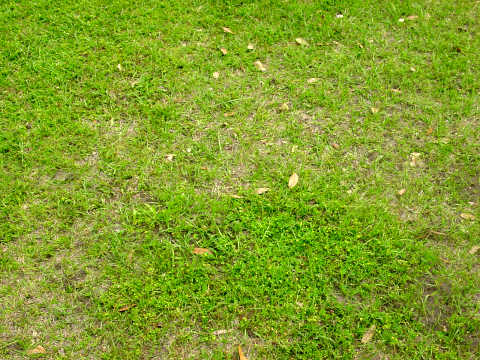 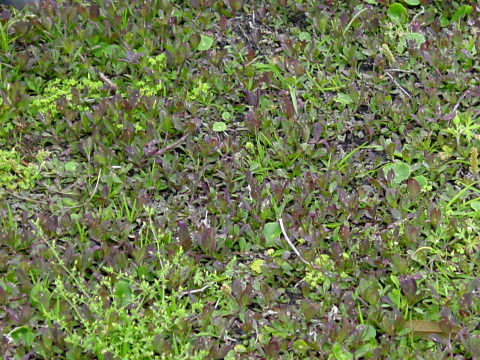 |
| Dunes of Cumberland Island |
|
| Something about the
starkness of this image appeals to me. It is nature's
artwork. It was on these dunes that I felt like I understood why these horses all seemed to have walls that extended up to an inch past the level of the sole. In my mild tread boots, I quickly found that I was working very hard to get virtually nowhere on the shifting sands of the dunes. So were Derry and Steve. Yet these horses moved about with ease and, when needed, with surprising speed. It dawned on us that these "overgrown" walls, created what amounted to a shovel on the end of each foot allowing exceptional traction on the dunes. |
 |
| If you look closely, you
can see the horse in the distance in the middle of this
picture. With our lack of traction, it took forever to get
to where this horse is and by then he was long gone. |
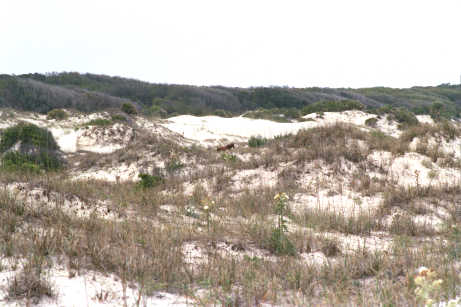 |
| This picture is of a mare
heavy with her current pregnancy and her white yearling
from last season. |
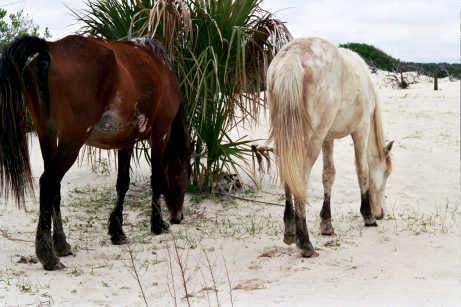 |
| Here is a close up of the
feet where you can see the advantage to the "shovel" foot
in the deep, unstable sand. |
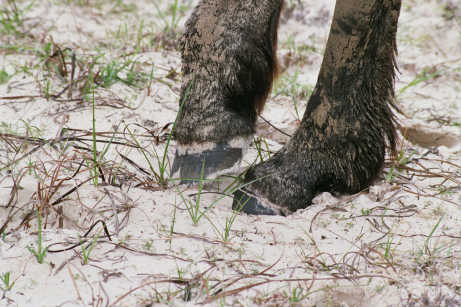 |
| This is an example of what
the horses were feeding on in the dunes. |
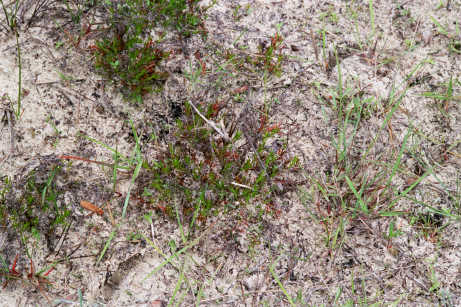 |
| Here is a bachelor band on
the beach. There was a constant cooling breeze that made
it virtually impossible for flying insects to pester the
horses (and us). It may be that they came here to get away
from the insects. You can see the long sharp toes that dig very effectively into the sand as the horse walks. |
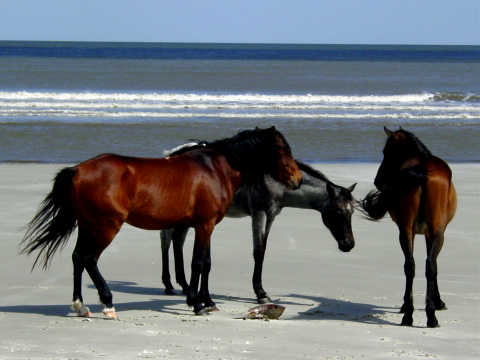 |
| This family group was a
considerable distance down the beach from the bachelor
band above. The stallion in the foreground kept an intense
watch on the bachelors. We walked past this family and
headed toward the bachelors. We noticed that up on the top of the first ridge of dunes were periodic stud piles. The bachelors eventually wandered off the beach and up the dunes. One bachelor began sniffing what appeared to be the last pile between where this stallion and his family were standing. The bachelor made his deposit on the pile then stepped over it on the side closest to this family. In an instant we heard a thunder of hooves and the stallion flew past us and sent those bachelors packing. It was breathtaking to say the least, and then amusing, as we realized this stallion was guarding his border even though the bachelors were a considerable distance away, and all it took was one foot placed on the wrong side of the stud pile to illicit a reminder of who is in charge! |
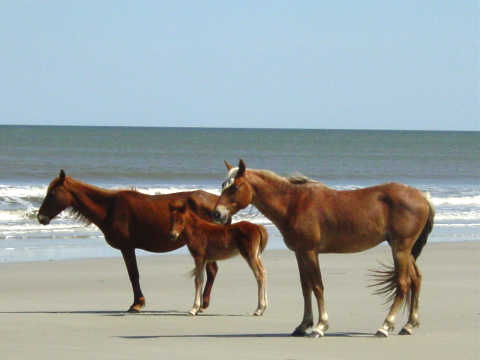 |
| Meadows of Cumberland |
|
| The inland areas hosted
some modest, as well as some vast meadows. |
 |
| Two young stallions
strutting and showing off. The mares in this meadow seemed
completely unimpressed. We were impressed, though! |
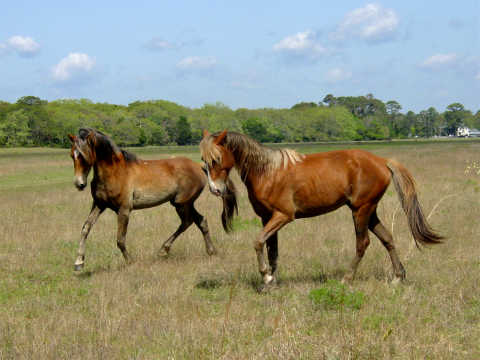 |
| This handsome fellow was
the picture of health. Much more robust in body than many
of his fellows. |
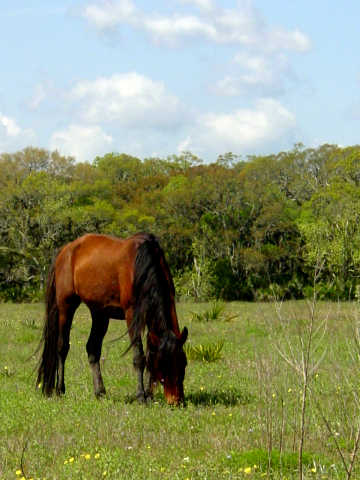 |
| These are some of the
plants growing in the meadow along with rather sparse, dry
grass. |
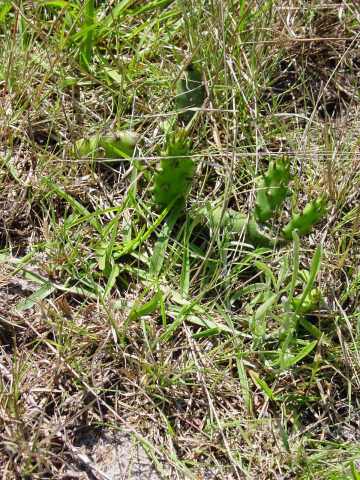  |
| Marshes of Cumberland |
|
| As you might imagine, there
are vast areas of marsh on the island. The horses spent a
significant part of their day grazing fetlock deep on
water plants. |
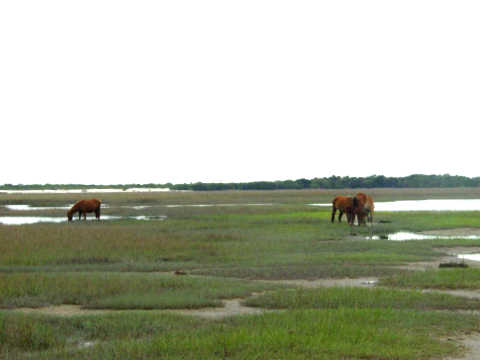 |
| This is the same young mare
we observed with the aged mare at Dungeness. She and her
small group had moved into the marsh area by the end of
the day. |
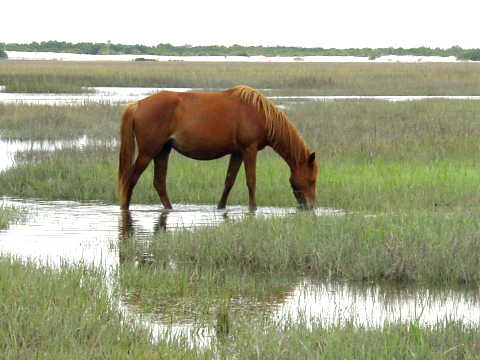 |
| She is foraging on what I
call saw grass. The long edges are serrated and will
indeed cut you if you run your finger down it. |
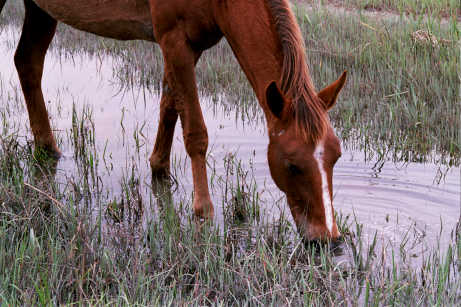 |
| This youngster was foraging
among the pickle grass. |
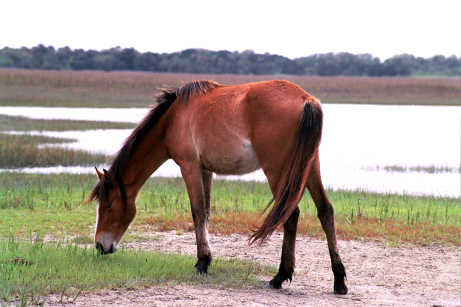 |
| This is what I used to call pickle grass when I was a child growing up on the south Florida coast. It is a succulent and has a slightly bitter taste that my young friends and I would occasionally eat. I don't yet know what it actually is, but clearly it is quite edible for the horses (and humans)! | 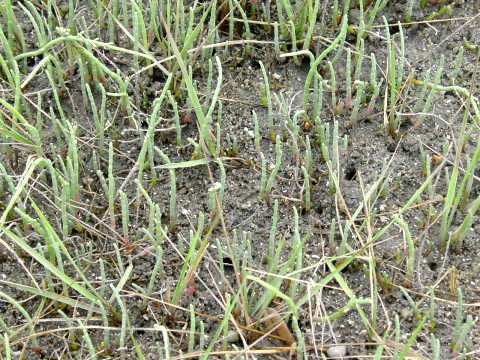 |
| Forests of Cumberland |
|
| Large areas of the island
are wooded to various degrees of density. |
 |
| Small meadows are scattered
about in the wooded areas. |
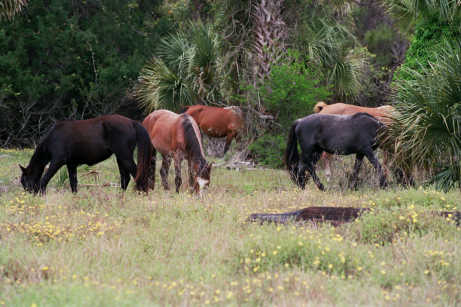 |
| The same white yearling we
saw on the dunes. |
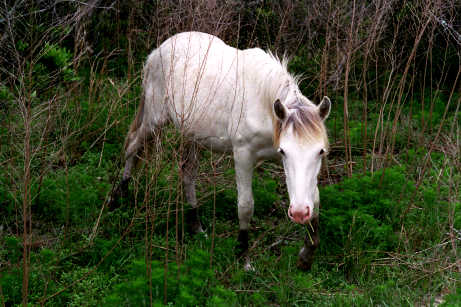 |
| Young gray stallion
completely alone when we first came upon him. There were
no other horses anywhere near him that we could see, nor
could we hear any moving about in the forest. However, he
seemed unconcerned about his solitude. Later we saw him in the company of another young stallion. |
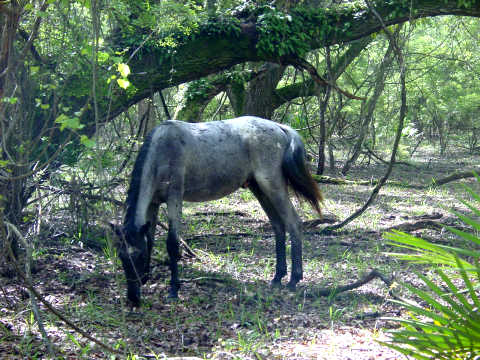 |
| A fleeting view of the gray
stallion's feet as he moved off into the woods. |
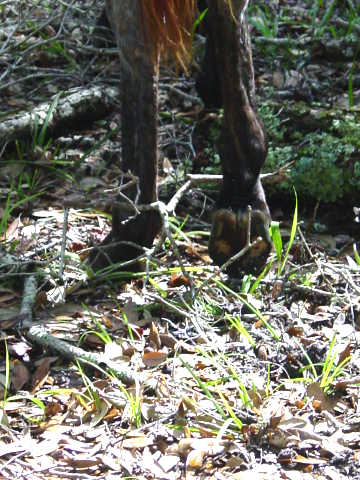 |
| This stallion was munching
on this fern-like plant. |
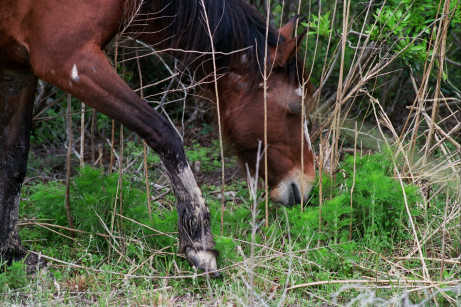 |
Well there is a start
folks. I'll add more as I have time to filter through
the volumes of pictures and video the three of us took
on this trip.
Enjoy! |
|
| A great site for information on barrier island horses is HoofPrints In The Sand I also highly recommend her book. |
| Barrier
Island
Wild Horses Eastern U.S. - Prairie Wild Horses
-
Wild Horses on the
Moor, U.K. - New Zealand Wild Horses
- Virginia Wild
Ponies Wild Burros - Wild Horses of Central Asia |
[Home]